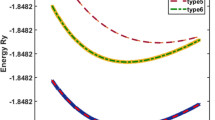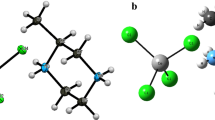Abstract
In the present investigation, the first hyperpolarizability of alkali and alkaline earth metal derivatives of cyclooctatetraene (COT) has been calculated using BHHLYP and CAM-B3LYP functional for 6-311++G(d,p), 6-311++G(3df,3pd), and aug-pc 2 basis sets. Introduction of Na/K atoms at the axial position of COT and Li, Na, K/Be, Mg, Ca metal atoms and cyanide groups at the equatorial sites leads to lager enhancement of first hyperpolarizability. The ring charge density can account for the variation of first hyperpolarizability. The two state model has been invoked to explain the variation of first hyperpolarizability.

Similar content being viewed by others
Change history
04 October 2017
The original version of this article unfortunately contained a mistake. Schemes I and II were missing. These important components are given below.
References
Parasad PN, Williams DJ (1991) Introduction to nonlinear optical effects in molecules and polymers. Wiley, New York
Marder SR, Kippelen B, Jen AK-Y, Peyghambarian N (1997) Design and synthesis of chromophores and polymers for electro-optic and photorefractive applications. Nature 388:845–851
Kurumida J, Yoo SJB (2012) Nonlinear optical signal processing in optical packet switching systems. IEEE J Sel Top Quantum Electron 18:978–987
Shi Y, Zhang C, Bechtel JH, Dalton LR, Robinson BH, Steier WH (2000) Low (Sub–1-Volt) halfwave voltage polymeric electro-optic modulators achieved by controlling chromophore shape. Science 288(5463):119–122
Silly MG, Porres L, Mongin O, Chollet PA, Blanchard- Desce M (2003) Optical limiting in the red–NIR range with soluble two-photon absorbing molecules. Chem Phys Lett 379:74–80
Chemla DS, Zyss J (1987) Nonlinear optical properties of organic molecules and crystals. Academic, New York, p 1
Dalton LR, Harper AW, Ghosn R, Steier WH, Ziari M, Fetterman H, Shi Y, Mustacich RV, Jen AKY, Shea KJ (1995) Synthesis and processing of improved organic second-order nonlinear optical materials for applications in photonics. Chem Mater 7(6):1060–1081
Roy RS, Nandi PK (2015) Exploring bridging effect on first hyperpolarizability. RSC Adv 5:103729–103738
Huijts RA, Hesselink GLJ (1989) Length dependence of the second-order polarizability in conjugated organic molecules. Chem Phys Lett 156:209–212
Meyers F, Marder SR, Pierce BM, Bredas JL (1994) Electric field modulated nonlinear optical properties of donor-acceptor polyenes: sum-over-states investigation of the relationship between molecular polarizabilities (.alpha., beta., and.gamma.) and bond length alternation. J Am Chem Soc 116(23):10703–10714
Zhang X, Wu HQ, Xu HL, Sun SL, Su ZM (2015) Modulating the charge transfer of D–S–A molecules: structures and NLO properties. J Phys Chem A 119(4):767–773
Lee MJA, Piao M, Jeong M-Y, Lee SH, Kang KM, Jeon S-J, Lim TG, Cho BR (2003) Novel azo octupoles with large first hyperpolarizabilities. J Mater Chem 13:1030–1037
Muhammad S, Xu H-L, Zhong R-L, Su Z-M, Sehemi AGA, Irfan A (2013) Quantum chemical design of nonlinear optical materials by sp2-hybridized carbon nanomaterials: issues and opportunities. J Mater Chem C 1:5439–5449
Csók Z, Sziraczki P, Kollár L, Ngo HM, Rak IL, Caturello NAMS, Albuquerque RQ (2015) Intramolecular cooperative effects in multichromophoric cavitands exhibiting nonlinear optical properties. J Phys Chem C 119(22):12608–12615
Wu K, Snijders JG, Lin C (2002) Reinvestigation of hydrogen bond effects on the polarizability and hyperpolarizability of urea molecular clusters. J Phys Chem B 106(35):8954–8958
Pilia L, Marinotto D, Pizzotti M, Tessore F, Robertson N (2016) High second-order NLO response exhibited by the first example of polymeric film incorporating a Diimine–Dithiolate square-planar complex: the [Ni(o-phen)(bdt)]. J Phys Chem C120(34):19286–19294
Maroulis G (2012) Quantifying the performance of conventional DFT methods on a class of difficult problems: the interaction (Hyper)polarizability of two water molecules as a test case. Int J Quantum Chem 112:2231–2241
Chen W, Li Z-R, Wu D, Gu F-L, Hao X-Y, Wang B-Q, Li R-J, Sun C-C (2004) The static polarizability and first hyperpolarizability of the water trimer anion: ab initio study. J Chem Phys 121(21):10489–10494
Wang JJ, Zhou ZJ, Bai Y, Liu ZB, Li Y, Wu D, Chen W, Li ZR, Sun CC (2012) The interaction between superalkalis (M3O, M = Na, K) and a C20F20 cage forming superalkali electride salt molecules with excess electrons inside the C20F20 cage: dramatic superalkali effect on the nonlinear optical property. J Mater Chem 22:9652–9657
Champagne B, Spassova M, Jadin J-B, Kirtman B (2002) Ab initio investigation of doping-enhanced electronic and vibrational second hyperpolarizability of polyacetylene chains. J Chem Phys 116:3935
Chen W, Li ZR, Wu D, Li Y, Sun CC, Gu FL (2005) The structure and the large nonlinear optical properties of Li@Calix[4]pyrrole. J Am Chem Soc 127(31):10977–10981
Wang FF, Li ZR, Wu D, Wang BQ, Li YZ, Li J, Chen W, Yu GT, Gu FL, Aoki Y (2008) Structures and considerable static first hyperpolarizabilities: new organic alkalides (M+@n6adz)M‘- (M, M‘= Li, Na, K; n = 2, 3) with cation inside and anion outside of the cage complexants. J Phys Chem B 112(4):1090–1094
Mai J, Gong S, Nan L, Luo Q, Zhiru L (2015) A novel class of compounds—superalkalides:M+(en)3M3 /O (M, M0 = Li, Na, and K; en = ethylenediamine)—with excellent nonlinear optical properties and high stabilities Phys. Chem Chem Phys 17:28754–28764
Muhammad S, Xu H, Liao Y, Kan Y, Su Z (2009) Quantum mechanical design and structure of the Li@B10H14 basket with a remarkably enhanced electro-optical response. J Am Chem Soc 131(33):11833–11840
Hatua K, Nandi PK (2015) Diradical character and second hyperpolarizability of multidecker inverse sandwich complexes of Mg and Ca. Chem Phys Lett 628:1–8
Hatua K, Nandi PK (2013) Beryllium-cyclobutadiene multidecker inverse sandwiches: electronic structure and second-hyperpolarizability. J Phys Chem A 117(47):12581–12589
Fray GI, Saxton RG (1978) The chemistry of cyclooctatetraene and its derivatives. Cambridge University Press, New York
Feixas F, Matito E, Sola M, Poater J (2008) Analysis of Hückel’s [4n + 2] rule through electronic delocalization measures. J Phys Chem A 112(50):13231–13238
Cao T, Ma Y, Yan X, Cheng J, Luo Y, He L, Zhu W (2009) Is free cyclooctatetraene dianion an aromatic system? a quantum chemistry study. J Chem 27:1914–1918
Hrovat DA, Borden WT (1992) CASSCF calculations find that a D8h geometry is the transition state for double bond shifting in cyclooctatetraene. 114 (14):5879–5881
Jones M Jr (2000) Organic chemistry. Norton, New York
Sokolov AY, Magers DB, Wu JI, Allen WD, Schleyer PR, Schaefer HF (2013) Free cyclooctatetraene dianion: planarity, aromaticity, and theoretical challenges. J Chem Theory Comput 9(10):4436–4443
Katz TJ (1960) The Cycloöctatetraenyl Dianion. J Am Chem Soc 82(14):3784–3785
Wayda AL, Ginsberg AP (1990) Inorganic synthesis, 27th edn. Wiley, New York, p 150
Harriman KLM, Murugesu M (2016) An organolanthanide building block approach to single-molecule magnets. Acc Chem Res 49(6):1158–1167
Hernández DP, López JAM, Pérez RA (2011) Bonding nature and electron delocalization of An(COT)2, An = Th, Pa, U. J Phys Chem A 115(32):8997–9003
Nakajo E, Masuda T, Yabushita S (2016) Theoretical study on the photoelectron spectra of Ln(COT)2 −: lanthanide dependence of the metal-ligand interaction. J Phys Chem A. doi:10.1021/acs.jpca.6b10930
Yanai T, Tew D, Handy N (2004) A new hybrid exchange–correlation functional using the Coulomb-attenuating method (CAM-B3LYP). Chem Phys Lett 393:51–57
Frisch MJ, Trucks GW, Schlegel HB, Scuseria GE, Robb MA, Cheeseman JR, Scalmani G, Barone V, Mennucci B, Petersson A (2009) Gaussian 09, revision A.02. Gaussian Inc, Wallingford
Becke AD (1993) A new mixing of Hartree–Fock and local density‐functional theories. J Chem Phys 98:1372–1377
Limacher PA, Mikkelsen KV, Lüthi HP (2009) On the accurate calculation of polarizabilities and second hyperpolarizabilities of polyacetylene oligomer chains using the CAM-B3LYP density functional. J Chem Phys 130:194114
Schleyer PR, Maerker C, Dransfeld A, Jiao H, Hommes NJRVE (1996) Nucleus-independent chemical shifts: a simple and efficient aromaticity probe. J Am Chem Soc 118(26):6317–6318
Acknowledgements
(RSR) acknowledges the UGC BSR (F.7-223/2009 (BSR) for financial support.
Author information
Authors and Affiliations
Corresponding author
Additional information
An erratum to this article is available at https://doi.org/10.1007/s00894-017-3466-x.
Electronic supplementary material
Below is the link to the electronic supplementary material.
ESM 1
(DOCX 71 kb)
Rights and permissions
About this article
Cite this article
Roy, R.S., Mondal, A. & Nandi, P.K. First hyperpolarizability of cyclooctatetraene modulated by alkali and alkaline earth metals. J Mol Model 23, 93 (2017). https://doi.org/10.1007/s00894-017-3273-4
Received:
Accepted:
Published:
DOI: https://doi.org/10.1007/s00894-017-3273-4




